Writing and notation in the Tai-Kadai languages of China and Southeast Asia
Dai of Jinping, Zhuang, Thái and Tày-Nùng.
The ethno-linguistic zone described here spans the entire border between China and Vietnam.

Scripts and notations of the Tai-Kadai languages in China and Southeast Asia
Dai of Jinping, Zhuang, Thái and Tày-Nùng
The ethno-linguistic area described here spans the entire border between China and Vietnam. The tai-kadai family, it should be remembered, owes its name to Benedict (1942) who combined the three words, each meaning "man", in tai, gelao and li. Since then, Ostapirat (2000) has proposed retaining only kadaï siamized into kra-dai (ขร้าไท), Ferlus (2006) even more demonstrative has derived gelao/lao from [k ra:w/kra:w] and taï/thaï, li/hlai from [k ri:/kri:].
All the "men" in this large family, whether called Dai, Tai in China or Thái, Tãy, Tay, Tày, Thay in Vietnam according to local pronunciations share a lexical corpus derived from "common Thai" defined as such by Haudricourt (1948). The same applies to Zhuang and Nùng.
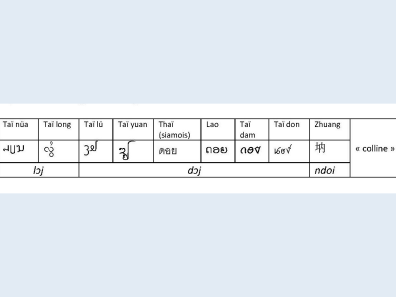
Rich in writing, they have no less than five traditional alphabets (taï nüa, taï long, tham, taï dam, taï don) forged from the Indo-Môn model for some and Indo-Khmer for others. It should be noted that some, such as the Zhuang, may have appropriated sinograms to write down their own language, and if the Daiya of Yunnan are illiterate, it's because, according to legend, their ancestors ate the buffalo hide on which the alphabet appeared...
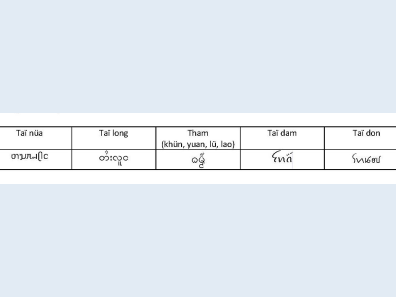
The Dai of Jinping, a district in the extreme south of the Yunnanese "Red River" department, are cousins to the Thái of Phong Thổ in northwestern Vietnam. Like them, they use the Taï don "white Taï" alphabet, rather than the Tham alphabet of the Lü, who are in the minority in these cross-border towns. In their script, consonants are aligned, surrounded by vowel signs, and syllables are devoid of diacritics, tonal markers. This is also the case for the taï dam "black taï" alphabet, a graphic variant of the previous one, in use among the Thái of Sơn La. As our friend Antoine Cam of Mường Tấc ironically put it, "Literate Thái don't need accents on words to understand a sentence". A gradual reform of Vietnam's two main Thái alphabets was initiated in 1955, with the aim of bringing each subscribed or subscribed vowel sign onto the line, indicating tones at the end of syllables and improving the transcription of Vietnamese. This "unified" script, presented in a publication by Lương Hải Nhì (1966), was strongly criticized from 1969 as superfluous and unpopular. As early as 1995, Vietnamese linguists launched a computer project to create a typeface based on the ancient "black tai" of Sơn La, which received unicode treatment in 2005.

Less well known and almost forgotten is a third traditional alphabet, that of the Thái of Quỳ Châu in Nghệ An province, written vertically in columns from right to left.
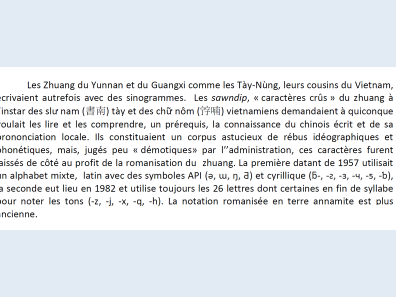
Codified in the mid-17th century by Alexandre de Rhodes, it became a true "national language script" (chữ quốc ngữ) at the end of the 19th century, then used to transcribe minority languages such as Thái and Tày-Nùng. Minot (1940), Lục (1974) and Hoàng (1990) contributed greatly to the adjustments of this Latinization. In conclusion, let's also mention Martini (1954) who, as early as 1947, in the midst of the Indochina War, developed a "Frenchized" alphabet for administrative and community use in the 'Tay Federation of Đèo Văn Long. Fallen into oblivion, it sometimes resurfaces, revived in the text messages and e-mails of the sons of exiles, from Toulouse to Orly.
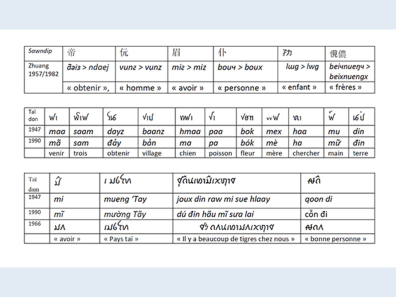
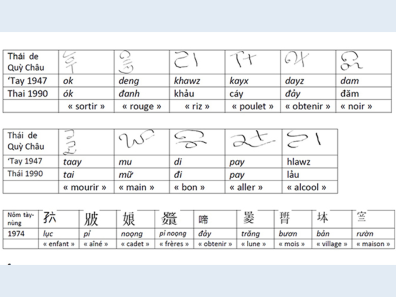
Tai-Luc NGUYEN TAN
Lecturer in the Lao Section
Sources
BENEDICT, Paul K., Thai, Kadai and Indonesian: a new alignment in Southeastern Asia, 1942.
FERLUS, Michel. "Sur l'origine de quelques ethnonymes : tai/thai, li/hlai, yi, gelao, lao, ... (South China, Southeast Asia)", XXe Journées de Linguistique Asie Orientale, June 2006. HAUDRICOURT, Georges-André, Les Phonèmes et le vocabulaire du thaï commun, Journal Asiatique, 1948.
HOÀNG, Trần Nghịch, Từ điển Thái - Việt, Viện ngộn ngữ học - Ủy ban nhân dân tĩnh Sơn La Nhà xuất bản khoa học xã hội, Hà Nội, 1990.
HOÀNG Văn Ma - LỤC Văn Pảo - HOÀNG Chí, Từ điển Tày - Nùng - Việt, Viện ngộn ngữ học - Ủy ban khoa học xã hội, Hà Nội, 1974. MARTINI, François, Romanisation des parlers 'tay du Nord-Viêtnam, Bulletin de l'École française d'Extrême-Orient, tome 46, n°2,1954.
MINOT, Georges, Dictionnaire tay blanc-français, Bulletin de l'École française d'Extrême-Orient, vol. 40, n°1, 1940.
NGUYEN TAN, Tai-Luc, De l'écriture tai-taiy-'tay, Sib Hook Chaw 'Tay, n° 17, Orly, December 1990. Parlons lü, la langue taï des douze mille rizières du Yunnan, L'Harmattan, Paris, 2008.
LƯƠNG, Hải Nhì , Sách học chữ thái cải tiến ("Manuel d'étude d'écriture thái réformée"), 1966.
OSTAPIRAT, Weera, Proto-Kra. Linguistics of the Tibeto-Burman Area, 23 (1) Monograph, 2000.